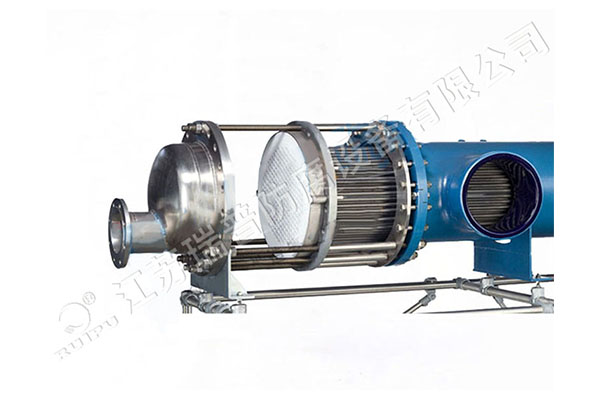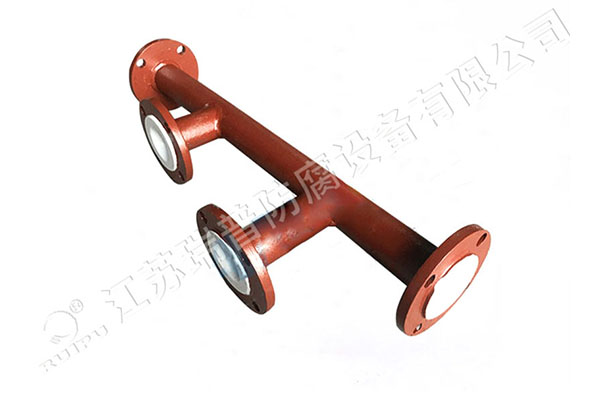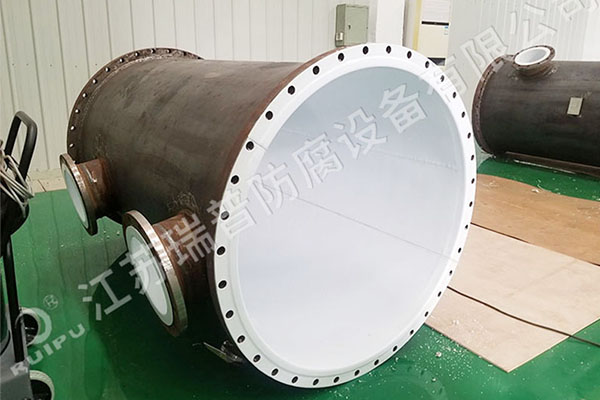How do lined storage tanks improve safety in the chemical industry?
Release Time : 2025-08-07
In the chemical industry, storing and handling a variety of corrosive, toxic, or flammable substances is a daily routine. These substances place extremely high demands on storage vessels, requiring them to not only withstand chemical corrosion but also ensure long-term safety and reliability. By utilizing advanced manufacturing processes and high-performance materials, lined storage tanks provide superior safety for the chemical industry, significantly enhancing the overall safety of storage facilities.
First, lined storage tanks utilize integrated steel-plastic molding technology, tightly integrating the plastic lining with the steel base to form a strong and stable structure. This design not only enhances the overall strength of the storage tank but also effectively prevents deformation or cracking caused by environmental fluctuations. Traditional single-material storage tanks, particularly in high-temperature and high-pressure environments, can experience uneven expansion and contraction, leading to the risk of leakage. Integrated steel-plastic storage tanks, on the other hand, are better able to withstand temperature fluctuations, maintain structural stability, and mitigate potential safety hazards.
Secondly, the use of imported high-performance raw materials such as ETFE (F-40) and PO as the lining material imparts excellent corrosion resistance to the storage tank. These materials possess exceptional chemical stability, resisting corrosion from most acids, bases, salts, and other corrosive media. This means the lining remains intact for extended periods, even under extremely harsh operating conditions, preventing leaks caused by corrosion. Furthermore, the use of high-performance materials extends the storage tank's service life, reduces maintenance costs, and further improves overall economic efficiency.
Furthermore, the use of a hot spin process creates a seamless bond between the plastic and the steel substrate, ensuring the integrity of the lining. This process creates a tight bond between the two materials at the molecular level, eliminating weaknesses that can occur with traditional welding or bonding methods. As a result, the lining not only offers high impact resistance but also effectively prevents localized damage caused by mechanical damage. In actual operation, even in the event of accidental impact or internal pressure fluctuations, the storage tank remains sealed, ensuring the safety of stored materials.
Additionally, the lining's design details contribute significantly to enhanced safety. For example, the seamless design ensures the continuity and smoothness of the lining's surface, eliminating any pores or gaps that could cause leaks. Furthermore, the smooth, glossy surface, resembling the exquisiteness of enamel, is not only aesthetically pleasing but, more importantly, reduces the adhesion of dirt and impurities, making cleaning and maintenance easier. The low coefficient of friction also ensures smoother liquid flow, preventing scale buildup and pipe clogging, thus maintaining system operation. These combined features significantly reduce safety risks associated with equipment failure or improper maintenance.
The lining's anti-permeability performance is also a key advantage. In chemical production, the leakage of certain highly hazardous substances can have devastating consequences. However, thanks to its excellent anti-permeability properties, corrosion-resistant lined storage tanks effectively prevent harmful substances from penetrating the wall, protecting the external environment from contamination. Furthermore, its high impact resistance ensures the tank remains intact even after external impact, further enhancing its protective capabilities.
From an environmental perspective, corrosion-resistant lined storage tanks also play a vital role. With growing global awareness of environmental protection, reducing industrial waste emissions has become a key responsibility for businesses. The use of high-performance lining materials can significantly reduce waste leakage caused by corrosion, conserving resources and reducing environmental pollution. At the same time, some manufacturers are actively exploring more environmentally friendly production processes and technologies, striving to reduce their carbon footprint throughout their entire lifecycle and promote green and sustainable development.
Finally, customized storage tank lining solutions are particularly important for specialized applications. Different chemical processes place unique demands on storage vessels, and standardized products often fail to meet all requirements. By deeply understanding the user's specific operating conditions and needs, we can provide tailored lining solutions that not only optimize storage tank performance but also specifically address potential safety issues. Whether it's a complex shape or a unique size, precise design and manufacturing can achieve optimal results.
In summary, corrosion-resistant lined storage tanks, through the application of a variety of advanced technologies and high-performance materials, significantly enhance safety in the chemical industry. They not only effectively resist corrosion from corrosive substances but also withstand a variety of harsh operating environments, ensuring long-term stable operation. Furthermore, their excellent permeation resistance and impact resistance further enhance the tank's protective capabilities, providing a solid guarantee for safe production in the chemical industry. In the future, with the advancement of technology and changes in market demand, it is believed that lined anti-corrosion storage tanks will demonstrate their irreplaceable value in more fields, helping various industries achieve higher levels of safety management and environmental protection goals.
First, lined storage tanks utilize integrated steel-plastic molding technology, tightly integrating the plastic lining with the steel base to form a strong and stable structure. This design not only enhances the overall strength of the storage tank but also effectively prevents deformation or cracking caused by environmental fluctuations. Traditional single-material storage tanks, particularly in high-temperature and high-pressure environments, can experience uneven expansion and contraction, leading to the risk of leakage. Integrated steel-plastic storage tanks, on the other hand, are better able to withstand temperature fluctuations, maintain structural stability, and mitigate potential safety hazards.
Secondly, the use of imported high-performance raw materials such as ETFE (F-40) and PO as the lining material imparts excellent corrosion resistance to the storage tank. These materials possess exceptional chemical stability, resisting corrosion from most acids, bases, salts, and other corrosive media. This means the lining remains intact for extended periods, even under extremely harsh operating conditions, preventing leaks caused by corrosion. Furthermore, the use of high-performance materials extends the storage tank's service life, reduces maintenance costs, and further improves overall economic efficiency.
Furthermore, the use of a hot spin process creates a seamless bond between the plastic and the steel substrate, ensuring the integrity of the lining. This process creates a tight bond between the two materials at the molecular level, eliminating weaknesses that can occur with traditional welding or bonding methods. As a result, the lining not only offers high impact resistance but also effectively prevents localized damage caused by mechanical damage. In actual operation, even in the event of accidental impact or internal pressure fluctuations, the storage tank remains sealed, ensuring the safety of stored materials.
Additionally, the lining's design details contribute significantly to enhanced safety. For example, the seamless design ensures the continuity and smoothness of the lining's surface, eliminating any pores or gaps that could cause leaks. Furthermore, the smooth, glossy surface, resembling the exquisiteness of enamel, is not only aesthetically pleasing but, more importantly, reduces the adhesion of dirt and impurities, making cleaning and maintenance easier. The low coefficient of friction also ensures smoother liquid flow, preventing scale buildup and pipe clogging, thus maintaining system operation. These combined features significantly reduce safety risks associated with equipment failure or improper maintenance.
The lining's anti-permeability performance is also a key advantage. In chemical production, the leakage of certain highly hazardous substances can have devastating consequences. However, thanks to its excellent anti-permeability properties, corrosion-resistant lined storage tanks effectively prevent harmful substances from penetrating the wall, protecting the external environment from contamination. Furthermore, its high impact resistance ensures the tank remains intact even after external impact, further enhancing its protective capabilities.
From an environmental perspective, corrosion-resistant lined storage tanks also play a vital role. With growing global awareness of environmental protection, reducing industrial waste emissions has become a key responsibility for businesses. The use of high-performance lining materials can significantly reduce waste leakage caused by corrosion, conserving resources and reducing environmental pollution. At the same time, some manufacturers are actively exploring more environmentally friendly production processes and technologies, striving to reduce their carbon footprint throughout their entire lifecycle and promote green and sustainable development.
Finally, customized storage tank lining solutions are particularly important for specialized applications. Different chemical processes place unique demands on storage vessels, and standardized products often fail to meet all requirements. By deeply understanding the user's specific operating conditions and needs, we can provide tailored lining solutions that not only optimize storage tank performance but also specifically address potential safety issues. Whether it's a complex shape or a unique size, precise design and manufacturing can achieve optimal results.
In summary, corrosion-resistant lined storage tanks, through the application of a variety of advanced technologies and high-performance materials, significantly enhance safety in the chemical industry. They not only effectively resist corrosion from corrosive substances but also withstand a variety of harsh operating environments, ensuring long-term stable operation. Furthermore, their excellent permeation resistance and impact resistance further enhance the tank's protective capabilities, providing a solid guarantee for safe production in the chemical industry. In the future, with the advancement of technology and changes in market demand, it is believed that lined anti-corrosion storage tanks will demonstrate their irreplaceable value in more fields, helping various industries achieve higher levels of safety management and environmental protection goals.







